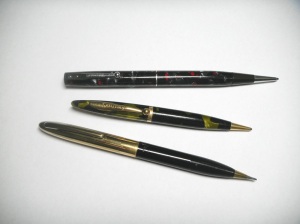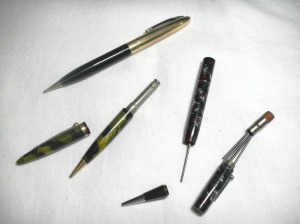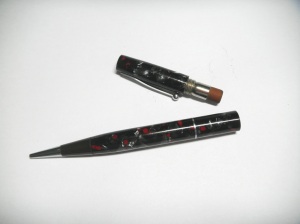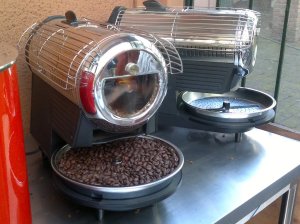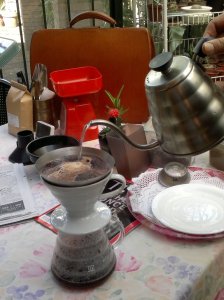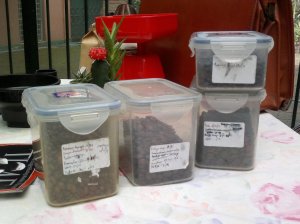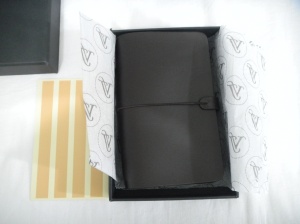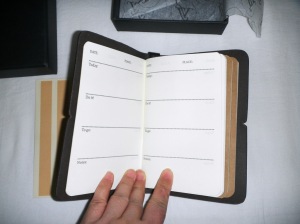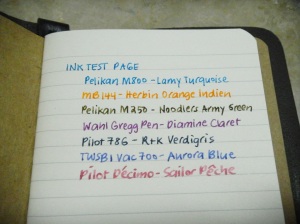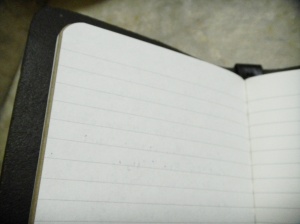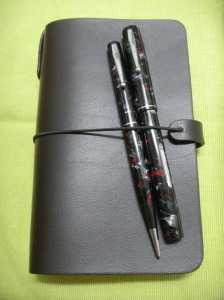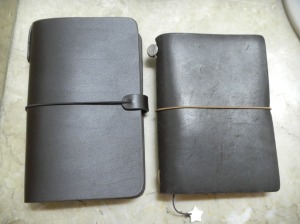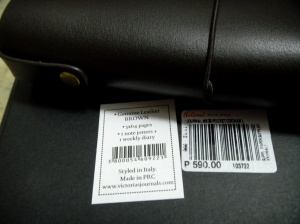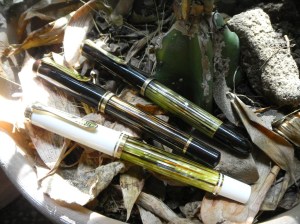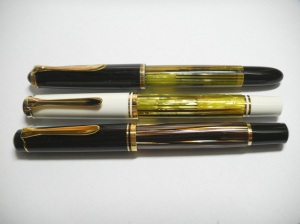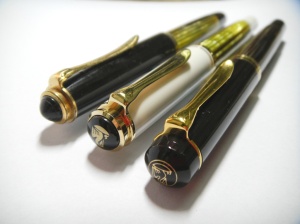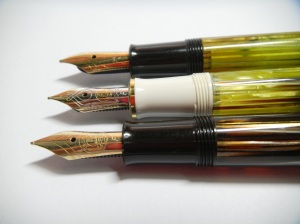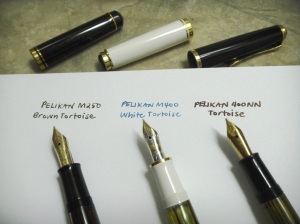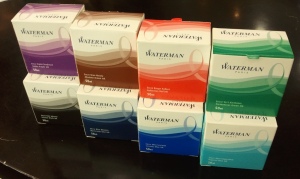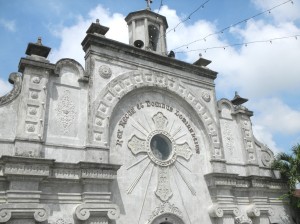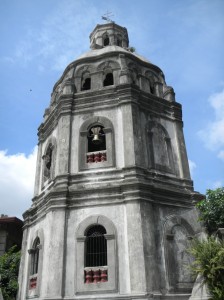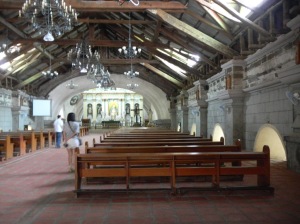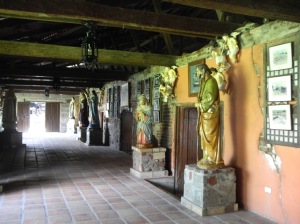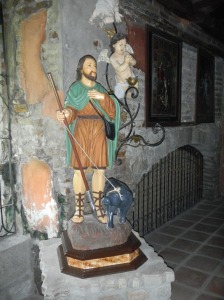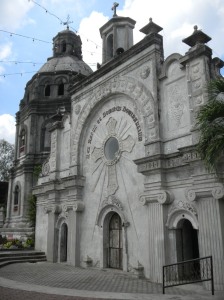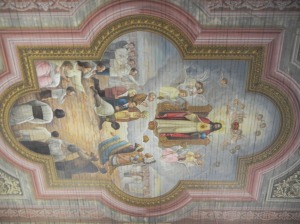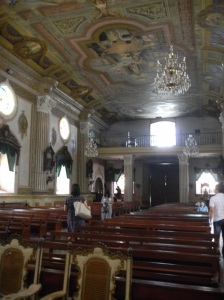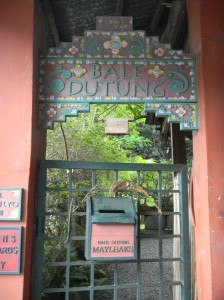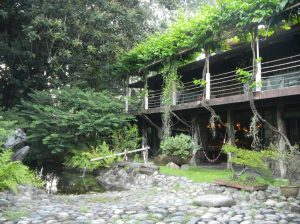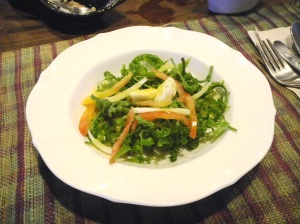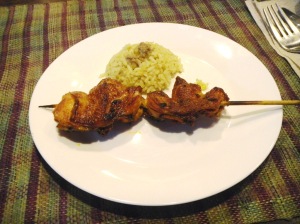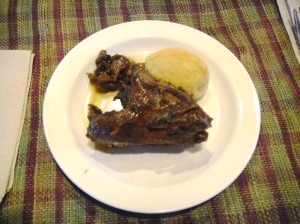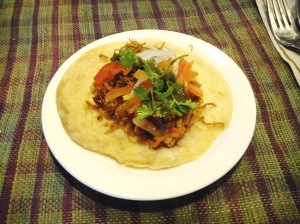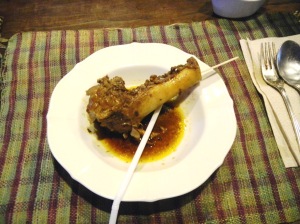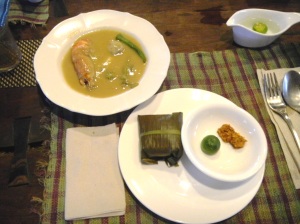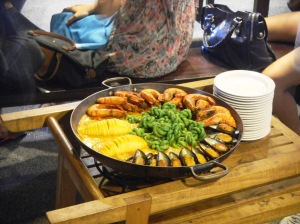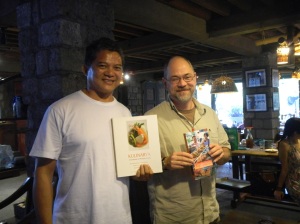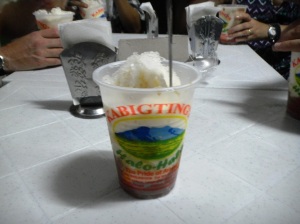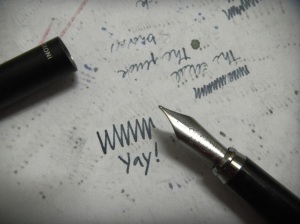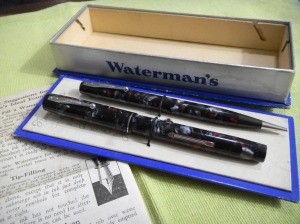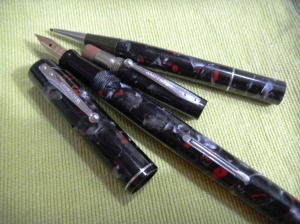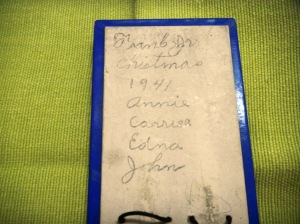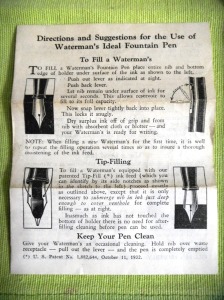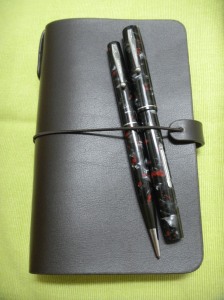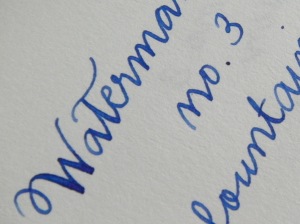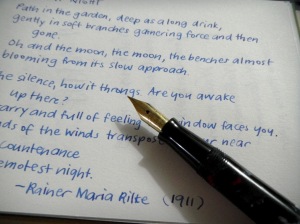Tuesday, March 12, 2013
Attractions of the Vintage Pencil
The other night I was cleaning a vintage fountain pen-and-pencil set that I wanted to sell. It was a 1930s Marine Green Sheaffer Balance mismatched pair - while the fountain pen was the standard length, the propelling pencil of the same pattern was shorter, sized for a vest pen. (I originally acquired them together, from the Fountain Pen Network Classifieds section a few years ago. Since then I was able to find a White Dot version in the same celluloid, so it was time to pass this pair on.)
I find that for some enthusiasts, the vintage pencil is an afterthought. Not many actually use the pencils as much as they would the fountain pens. Sellers sometimes break up sets in order to more easily sell the items. Maybe that's how my little vest pencil got orphaned, and later matched up with the wrong size pen. Some people, on the other hand, end up collecting vintage pencils for their beautiful celluloid (unblemished by latex sacs or staining ink).
Propelling pencils are writing tip-loading twist action pens. To expel old lead, you twist the pencil clockwise to push the lead upwards and out. Then you twist the other way until the metal pin that pushes the lead is fully retracted. You place the appropriate size lead in through the pen's nose cone and press the protruding tip onto the paper to make sure the lead is securely lodged. If you're not sure how to load your pencil, the blog Dave's Mechanical Pencils gives instructions, according to brand and era.
It was while learning how to refill the pencil that I realized it contained the wrong size lead. It was a 0.9mm lead that kept falling out. I cleaned out residue from the nose cone with a straight pin and tried some vintage Scripto 1.1mm lead that a friend gave me. It was a perfect fit! By the end of that exercise I realized I had fallen in love with the tiny pencil and just decided to keep it.
Richard Binder mentions that vintage Sheaffers and Parkers usually use 0.9mm leads, but not in this case. Pendemonium is another good source for vintage leads (the site navigation is not that intuitive, but go to Pen Repairs Supplies and select Pencil Leads). The most common sizes sold locally are 0.5mm and 0.7mm leads for modern mechanical pencils, but 0.9mm is available if you look for Japanese or Korean pencil brands (I use MonAmi).
I couldn't resist checking out the Waterman Ideal No. 3 propelling pencil that I received as a gift last January. I took it apart and discovered that the cap end unscrews to expose the eraser. I heard pencil lead rattling inside the eraser tube, so I pulled the eraser tube out and found a stash of short 1.1mm leads! The nose cone twists to propel the lead, but there wasn't much traction, so I lined the mechanism with a bit of latex and gently turned it with my pliers. I'll see later if a layer of dried shellac can thicken the diameter of the brass tube and provide traction for the nose cone (no, I'm not gluing them together). I'm not using the vintage eraser on this one - I have my favorite modern eraser (Staedtler Mars Plastic) for that.
For most daily use my 1940s Sheaffer Crest pencil with 0.9mm lead is pretty good. It's part of a set, too. I do have a couple of other modern plastic mechanical pencils, but right now they're not getting that much attention. The pretty vintage celluloid and the solid build appeal to me. It's not a collecting direction I'll be taking, but I sure do appreciate the fact that they're decades old and still work!
To learn more about vintage pencils, check out Jon Veley's The Leadhead's Pencil Blog. Jon Veley also wrote the book The Catalogue of American Mechanical Pencils and maintains The Mechanical Pencil Online Museum.
Posted by The Gravelcat at 9:56 PM 0 comments
Labels: Hobbies and Crafts, Mechanical Pencils, Vintage, Writing Instruments
Sunday, February 24, 2013
Coffee Safari
Today I went with friends on a coffee safari. No, we didn't hop from
one coffee shop to another! We were invited to a coffee-tasting at a
friend's home. The coffees, however, came from exotic locales - where
the best coffees grow.
I had no idea my friend Dante was a member of a local coffee club. As you can guess, he doesn't have coffee at coffee shops because he enjoys making his own at home. He has a collection of coffee gadgets, ranging from grinders, to roasters, to French presses and espresso machines! He buys international single-origin coffee beans from a trusted source, and only roasts 250g of beans at a time. He grinds his beans just before making his coffee, in order to take advantage of the beans' freshly-released flavor and aroma.
We had, in order: Peruvian, Ethiopian dry-process (where the coffee berries dry in the sun naturally, as opposed to wet-process where the berries are hulled and the beans are dried separately), Jamaican Blue Mountain, Panama La Esmeralda Gesha and Ethiopian Harar coffees. Plus an Ethiopian dry-process Americano (1:1 espresso and water).
Dante used the hand drip coffee method. I was wondering if the ceramic dripper was available locally, and found out it was being sold at Craft Coffee Workshop along Broadway Ave. in New Manila, Quezon City. It's also available in different sizes , along with other coffee accessories, on Amazon.com.
The coffees all had a wonderful aroma, each different from the other. The aroma of the ground coffee was much stronger than that of the whole roasted beans. I wish I had taken tasting notes, but I don't know the terms. Dante arranged the progression of flavors in terms of complexity and body. I guess it would be like how a sommelier arranges wines to complement a dinner. We tried each coffee black, then with some muscovado sugar, then with non-dairy creamer. All the coffees were very good, but the Jamaican Blue Mountain and Panama La Esmeralda Gesha were particularly delicious. Sublime. (Jude, to me: "So, did you hear the choir of angels yet?" With my mouth full of coffee, all I could do was nod and smile.)
Yes, we had a LOT of coffee, in small cups, not the big American-size mugs. We were served pan de sal (soft breakfast buns), with our choice of filling - butter, strawberry jam, peanut butter and Spanish-style sardines. We also had a lot of water on the side, to cleanse our palates. You would think that all that caffeine would render me into a quivering mess, but I checked my hands and they didn't shake. Dante explains that when coffee has been made properly, you get the flavor of the coffee without too much of the caffeine. To prove his point, he served me and Christine an Americano each, made of the Ethiopian dry-process beans. My sixth coffee, but in a tiny double espresso cup. I felt extraordinarily alert, but I felt great! No palpitations.
Of course, this isn't something I'd do on a daily basis. I don't think I'd ever get to experience that in a commercial coffee shop, or even in a hotel. It was such a treat (thank you so much, Dante)! I learned so much about coffee that I never knew before.
I like to support Philippine coffee bean producers. My usual coffee at home is Arabica from the Cordilleras or Liberica from Batangas ("barako"), so Dante suggested I try the local coffee brand Monks' Blend. It's produced by Benedictine monks from the Monastery of the Transfiguration in Malaybalay, Bukidnon. We have an active Philippine Coffee Board, so maybe one day I'll work my way through the different local coffees, which I see being sold in organic weekend markets, food trade fairs and sustainable lifestyle stores like Echo Store.
Posted by The Gravelcat at 5:42 PM 0 comments
Thursday, February 14, 2013
A Many-Splendored Thing
It was 1957. The acacia trees lining the avenues at the University of the Philippines campus in Diliman were not as tall and leafy as they are now. He saw her walking to class one day. She walked with a certain spring in her step, clutching her books. "Magarput" is his word. It's an Ilocano word that's hard to translate, but it connotes a certain kind of vivacious girliness. He kept an eye out for this "magarput" little Chinese girl from the sugar lands of the South, who mostly spoke English because she didn't know much Tagalog, the lingua franca of Manila. She graduated class salutatorian from Negros Occidental High School. In those days being an honors graduate automatically granted young students admission to UP Diliman.
She had no idea he was interested, until much later. He was a good-looking Northern boy from the summer capital, Baguio City, and he was in UP to study mining engineering. With other Ilocano boys he roomed at Narra Residence Hall and spent some of his free time with his fraternity brothers, or riding around in his friend's Volkswagen Beetle serenading young ladies at the nearby dormitories. She stayed at the YWCA dormitory across the street, where, every Sunday, they served the best fried chicken on campus. All the Narra boys dreamed of being invited to dine at the YWCA on Sundays!
My dad learned she was secretary of the youth organization at the UP Protestant Chapel, the Church of the Risen Lord. Naturally he joined, too. She had two other suitors, one of which became a top volcanologist, and the other, a prominent judge. But she only had eyes for my dad.
One fateful day he was returning to Narra Residence Hall from one of their dates, and came upon two fraternities fighting violently nearby. In the ensuing melee one boy stabbed him in the side! My mother brought him to the hospital, where she met my paternal grandmother for the very first time. When the boy who stabbed him found out that it was a case of mistaken identity, he was mortified. He apologized, and they later decided not to file charges against him. Oddly, a few years later, when my parents got married, he sent them a nice set of placemats.
My dad later joined an equipment firm, while my mom taught high school Biology at UP. They continued to see each other. On Valentine's Day in 1967 he went over to her faculty room and said, "Let's get married!" So off they went to Quezon City Hall. The two witnesses were my dad's best friend and the judge's secretary. They didn't have much money, so they went to Little Quiapo nearby and had a crushed ice dessert, halo-halo, to celebrate. It was many years later that my mother was finally able to introduce my father to her mother. My maternal grandma was fond of saying, "You know, I never met your father until after they got married, but he turned out to be my favorite son-in-law!"
Twenty-five years later they renewed their vows in church. They've been together 46 years now, best friends and lovers and parents. They are in their seventies. My dad jokes that their marriage has survived this long because he is deaf in one ear. My mom says it's because they each maintain their individual interests and yet support each other's pursuits.
But I think it's the romance, which is still quite strong. My friend Ana called me on the phone one night. The phone reception was very clear and she could hear everything going on in the living room, and even heard the doorbell ring. She heard the clattering of my mom's shoes on the marble. "Who's that? " she said. "It's my mom," I explained. "My dad just arrived." Suddenly it was quiet. "What's happening? Why is it quiet?" I laughed and said, "They're kissing!"
There are pink tulips in a little pot on the table tonight. It reminds me of the time he first gave her tulips many years ago. They were the exotic and fashionable imported flowers to give on Valentine's Day back then. We were all stuck in traffic on our way to their wedding anniversary dinner. After sniffing the tulips, she said with surprise, "But they don't smell of anything!" So he jumped out of the car and ran after a vendor selling sampaguita (jasmine) leis, and ran back. "Here!" he said, panting, giving my mother a lei. "Here's the scent!"
Ain't love grand.
Posted by The Gravelcat at 9:13 PM 0 comments
Labels: Anniversary, Family, Memory, Romance
Monday, February 11, 2013
Victoria's Leather Journal
Happy Chinese New Year! I know most of you already have 2013 diaries
and journals, but I discovered a leather journal recently that can give
the Midori Traveler's Notebook a run for its money. The thing that confused me about is that it's called a Pelle Leather Journal, by Victoria's Journals, but it's not the Pelle Leather Journal
you know of in the US, that directly competes against Midori. From
this point for purposes of clarity I'll be referring to it as the VJ.
Regardless of branding, the important thing to me was that the VJ is made of real leather. I found them in Bestsellers (a National Bookstore branch at the Podium in Ortigas Center), each in their own black box. I got one in brown.
Each journal fits three 9 x 14cm (roughly 3.5" x 5.5") notebooks: a to-do planner, a lined notebook and a blank notebook. There are Venzi flexi 2 notebooks (also made by Victoria's Journals, available at National Bookstore) that can be used as refills in case you can't find notebooks to fit. As for me, I make my own refills, because that means I can choose the paper quality - must be fountain pen ink-friendly!
And this paper is friendly, as long as you don't use a B nib that's an overly wet writer. There's not much bleedthrough or showthrough at all. Imagine that! I haven't been buying notebooks in a long time because I don't like spending money and then finding out the paper only takes ballpoint ink.
Here it is, with my Waterman's Ideal No. 3 set. And below, a comparison shot with my passport-sized Midori:
The feel of the Midori leather is a bit more luxurious. It takes distressing well. The Victoria's Journal journal is a little stiffer. I like the leather clasp that holds the covers together, it doesn't dent the cover as much as the plain elastic does. Also, the inside elastic fastenings don't require much fiddling with.
I posted this on the Fountain Pen Network-Philippines Facebook page, and sort of caused a shopping frenzy. Why? Because compared to the Midori (about USD55) this VJ journal costs only P590 (about USD15)! My friends and I found out that there are three colors: Black, Brown and Maroon. If you want your own and it hasn't been sold out yet, the magic stock number is 103722 at National Bookstore. Call them and reserve the item, before visiting.
The Midori is made in Thailand. The VJ box is marked "Styled in Italy. Made in PRC." So yes, it's made in China, even though they very cleverly try not to point that fact out. At least every part of it looks well made for the price.
To my friends in the US, the Victoria's Journal site only sells to the trade, I believe. You'll have to look for the item in your stationery store (although the site indicates they sell this item in the US). The Pelle Journal that's competing against the Midori (see links above) is a quality product and you can't go wrong with either brand.
Posted by The Gravelcat at 4:29 PM 0 comments
Labels: Journal, Leather, Victoria's Journal
Tuesday, February 5, 2013
Three Pelikan Tortoises
Back in 2009 I was trying to decide on a birthday fountain pen. I'm a Pelikan fan, and decided that I would save up for a Pelikan M400 White Tortoise with an F nib. It had just been reintroduced as a regular (and no longer limited production) pen. Prior to this my Pelikan flock was limited to M200s and M215s. It's the same size as an M200, only with a 14k two-tone nib. I got it for a good price brand new from a Singapore-based seller, and was delighted to see how pretty it was. Of course, since it was white, I read up on what inks I could safely use it with. For this I use low-maintenance blues, greens, browns and blacks (nothing red or purple, to avoid possible staining). To date it is my prettiest, blingy-est pen.
Last year my friend Hazel was streamlining her collection and put up her Pelikan 400NN Brown Tortoise for sale. I took a deep breath and immediately went for it. It's a 1950s model with a brown cap and piston knob. The tortoise stripes are mostly green, with a few brown glints here and there. The nib is a soft M, which I had gently stubbed by my friend J. P. so it would write with a bit more character. At the base of the pen there is an almost invisible imprint "Pelikan 400 Gunther Wagner Germany". The cap clip is a little brassed, but it is a pre-loved pen after all. I wasn't too worried about maintenance, since the 400NN pretty much had modern parts (no cork to replace on the piston). All it needed was for me to lubricate it, and that was easily done with a bit of silicone grease.
Top: Pelikan 400NN Brown Tortoise Middle: M400 White Tortoise Bottom: M250 Brown Tortoise
Now all I needed was a newer M400/M415 Brown Tortoise. The chances of finding one at a price I could afford were slim, until my friend Onggie showed me one of his eBay scores. "Hey, if you get tired of that, will you think of selling it to me?" I joked. Little did I know that a few months later I'd actually get to own it, at its eBay acquisition price! Of course when I saw it again, I realized that it was not the M400/M415 I thought it was, but the simpler and equally attractive M250 Brown Tortoise, a pen briefly issued by Levenger in 1997. I identified it by the cap, which is domed with an engraved logo filled in gold, and has a double cap ring that says "Pelikan Germany". The M400/M415 should have a double cap ring that says "Pelikan Souveran Germany". Also, the M250's piston knob does not have a ring, while that of the M400/M415 has a double ring. As with the 400NN, the M250 Brown Tortoise has a brown cap and piston knob. My pen sports an old-style monochrome F nib.
Writing sample. (Click photo to enlarge.)
There is a special edition M600 version of the White Tortoise. I love the size, but not the price. The M415 Brown Tortoise, also a special edition, is out of my budget, as is the much-rumored M800 version. The M101N Tortoise is lovely and is, alas, out of my reach. That won't stop me from admiring them, though.
I'm quite happy with my Three Tortoises.
Posted by The Gravelcat at 3:34 PM 0 comments
Labels: Fountain Pens, Hobbies and Crafts
Sunday, February 3, 2013
Buying Fountain Pen Inks in Manila
More and more people are growing interested in using fountain pens here in Manila, as evidenced by the growing membership in our pen group Fountain Pen Network-Philippines. For a long time Parker, Waterman, Cross and Montblanc were the only brands readily available in the local fountain pen market. Now there are new brands available: Lamy, Pelikan, Sailor, to name a few. Waterman,Aurora, Cross and Rotring are now no longer being sold here, while Sheaffer recently reintroduced itself. The local Pilot distributor sells only school pens, not the fine writing instruments, nor the ink.
I've compiled a list of stores that sell fountain pen inks, in bottles and cartridges as of 2013: (click on links to see directory info)
National Bookstore branches
- Parker, Lamy, Sheaffer, Inoxcrom (cartridges)
Montblanc branches - Makati (632) 813-3739, Powerplant Mall (632) 898-2347, Shangri-la Mall (632) 633-4636, Manila (632) 521-1140, Robinsons Place (632) 551-2095, Ayala Town Center (632) 850-5532
Scribe Writing Essentials - 3/F Eastwood Mall, QC. (632) 900-0053.
- Herbin, Lamy, Sailor, Pelikan (4001 and Edelstein)
Cutting Edge (Greenbelt 5)
- Waterman
Times Trading
- Lamy
As of this time, there are no local distributors yet for Noodler's, Diamine, Rohrer & Klingner, Aurora, Visconti, De Atramentis, Pilot (regular and Iroshizuku), Platinum and other popular brands of ink. For these, we resort to buying from eBay or online stores based overseas.
Posted by The Gravelcat at 9:20 PM 0 comments
Labels: Fountain Pens, Hobbies and Crafts, Retail Therapy
Saturday, February 2, 2013
Two Old Churches in Pampanga
Last August I joined a group of friends on a day tour of Pampanga.
It's north of Manila, about a drive of an hour and a half. We had a
special ten-course lunch scheduled at Bale Dutung, but had the morning free to visit a couple of old churches and take photos.
The San Guillermo Parish Church of Bacolor
dates back to Spanish times. After the original church (constructed in
1576) was destroyed in an earthquake, it was rebuilt in 1897. In 1991
half the church was buried in lahar during the eruption of Mt. Pinatubo.
In one of the photos below you'll see that the arched windows on the
sides of the church are now as low as the tops of the pews.
From Bacolor we traveled to Betis, Guagua - an old town famous for hand-carved furniture. Built in the 18th century, the Parish Church of Santiago Apostol (St. James the Apostle) is known for its splendid retablo art. Its facade is quite simple and relatively recent, but old carvings decorate the church door and selected pieces of the church's original wooden furniture. The altar is rich with more carvings, gilt and saints. But the showstopper is the church's ceiling, painted in the early 20th century. We were requested by church staff not to use flash photography, to protect the artwork.
Posted by The Gravelcat at 4:54 PM 0 comments
Labels: Arts and Culture, Friends, History, Philippines, Photography, Travel
Friday, February 1, 2013
Dining at Bale Dutung
When our American friend Tom said he'd finally visit the Philippines last August, Carlos immediately organized a trip to the province of Pampanga, complete with a ten-course lunch at Claude and Mary Ann Tayag's restaurant, Bale Dutung.
"Bale Dutung" means "house of wood". If this house looks somewhat familiar, it's because it was featured in Anthony Bourdain's Philippines episode on No Reservations. Here's the Pampanga clip on Youtube, showing artist and chef Claude Tayag's restaurant.
A salad of wild ferns and tomatoes topped with half a soft-boiled egg.
Grilled chicken buttons (it's the behind, folks!) with brown rice.
Quail stewed in soy sauce, garlic and vinegar (adobo), with egg pan de sal.
Lechon taco. Each diner is served only one ( in order for them to be able to appreciate the rest of the ten-course meal properly), but the fixings are buffet style.
Beef bone marrow. You get a wooden popsicle stick to scoop out the delicious marrow, plus a straw to help you get all the juices.
A thick guava-flavored soup called "bulanglang", featuring "ulang" (large river prawns). There's a small serving of plain rice inside the banana leaf package.
Seafood kare-kare (a stew with peanut sauce).
The courses I didn't photograph were the appetizers (crackers and dip made of homemade herb pesto, "taba ng talangka" or crab fat, and "balao-balao" or fermented rice flavored with shrimps); the coffee and dessert (maja blanca with corn and young coconut).
The meal took us four hours to consume! It was amazing how we could all still stand up at the end of it all. Claude visited our table and signed the books we bought. He and Mary Ann co-authored the book Linamnam, a regional food guide to the Philippines (Anvil Publishing, 2011). Claude also styled Kulinarya (A Guidebook to Philippine Cuisine), by Glenda Rosales Barretto.
Was it worth it? Foreign visitors and locals who aren't too familiar with Pampanga cuisine (like myself) can definitely check this menu out. Some of the dishes were known quantities with a distinctly Pampanga/Tayag twist. Some, like the balao-balao dip and the guava-redolent bulanglang, were exotic. If that doesn't strike your fancy, there are also other menus to choose from. I truly enjoyed Mary Ann's entertaining and informative spiels, and learned a lot about Pampanga's rich history and culture through its food.
What to do after an afternoon of eating? We decided we all wanted a richer dessert, and went all the way to Kabigting's a few towns away in Arayat, for white halo-halo (with pastillas milk candy instead of ube jam)!
Thank you, Tom, for visiting the Philippines, because if it weren't for you, we wouldn't have thought of going on this Pampanga food tour!
Posted by The Gravelcat at 2:49 PM 0 comments
Labels: Food, Friends, Philippines, Restaurants, Travel
Thursday, January 31, 2013
Tinker, Tinker
Everyone who's ever had a hobby has tried to learn as much as they can about the things that sustain their interest. I love writing with fountain pens, so I've managed to learn enough about them to maintain them, thanks to sites like the Fountain Pen Network, Pentrace, FPGeeks, among others.
I enjoy cleaning my pens, too. It's a kind of meditation in itself, whether manually, with a nasal aspirator or syringe, or with an ultrasonic cleaner - that's all good. I recommend this article, written by a friend.
And then there are times when some pens don't behave the way they should. At such times I am filled with a combination of annoyance and curiosity, and a hunger to make things work. I want to tinker, but of course one must be an informed tinkerer. I don't want to void a warranty, so I need to do research. It's not an inconvenience because I'm an enthusiast after all, and it's an opportunity to learn something new. When I finally get my misbehaving pens to write right, there's this incredible geeky rush!
We don't have fountain pen repair persons in the Philippines, so I must be able to do some basic repairs confidently enough to maintain my own pens. Twice this week I've been plagued by dry writers, and was able to resolve one issue on my own (and got customer service for the other).
So far I've learned how to pull out and reset friction-fit nibs and feeds (only when necessary). I've flossed tines with a piece of acetate to make the ink flow a bit wetter. I've smoothed scratchy nibs with micromesh. I can resac vintage lever-fillers (Esterbrooks, Watermans). I've learned how to disassemble and reassemble a piston-filler (TWSBI 530/540), also to lubricate those that I can't disassemble totally (Pelikans, Lamy 2000). I've managed to fix a Sheaffer Imperial (touchdown), so my other ambition is to repair a Sheaffer snorkel. Of course these links I've provided aren't enough, one must read as many sources as possible. I've been lucky to have more experienced friends demonstrate how certain repairs were done.
Do you enjoy tinkering (with fountain pens, cameras, cars, anything)?
Posted by The Gravelcat at 6:25 PM 0 comments
Labels: Fountain Pens, Hobbies and Crafts
Wednesday, January 30, 2013
Waterman's Ideal No. 3 Set
Some Saturdays come with a happy surprise. A package arrived for me last weekend! A good friend from the US sent over a combined Christmas and birthday gift in the form of a vintage Waterman’s Ideal No. 3 set of fountain pen and matching propelling pencil! It came complete with an original Waterman’s box, complete with paper insert of instructions on how to fill the pen and pencil correctly.
I could not stop staring. The celluloid was beautiful! The pen is pristine – the clip and lever are absolutely clean and shiny, the Waterman’s imprint on the barrel strong and easy to read. There are no major use marks. It’s been resacced, ready to fill and write with. The pencil still had its original eraser, and contained the right size lead!
When I removed the pen and pencil from the box I was delighted to discover a pencilled inscription: “Frank Jr. Christmas 1941 Annie Carrisa Edna John.” I like to think this was a gift to Frank Jr. from his siblings.
The paper insert mentioned a patent date of 1932, so the date of manufacture could’ve been close. (Later, my friend, a member of the Pen Collectors of America, discovered the very pen listed in a 1933 Waterman’s catalogue. The beautiful silvery-grey swirls in a black matrix with random red flecks is a celluloid pattern simply called “Black Pearl”.)
The nib is a sweet 14k no. 2 flexible fine. My friend tuned the flow to be able to write well under a light hand, and to be wet enough to handle flexing. I haven’t really tried any sustained Copperplate-ish writing with it yet, but I feel it can certainly used that way. (I’d say my Wahl and Swan pens have slightly softer flex nibs.) I did try a fancy capital W in my writing sample, however.
This pen and pencil set was acquired from an antique store sale. Back in the 1933 people paid USD 3 to buy this fountain pen. It might have been a bit more when it was given to Frank Jr. Vintage Waterman’s Ideal pens come from the time when the brand was still American and American-made – about 1884-1954. (Now owned by Newell Rubbermaid, today’s Waterman fountain pen brand is based in France.)
I have inked it with Cross Blue and intend to use it often – which is the best way to honor such a wonderful gift. And the best way to start the New Year!
Posted by The Gravelcat at 1:42 PM 0 comments
Labels: Fountain Pens, History, Hobbies and Crafts
